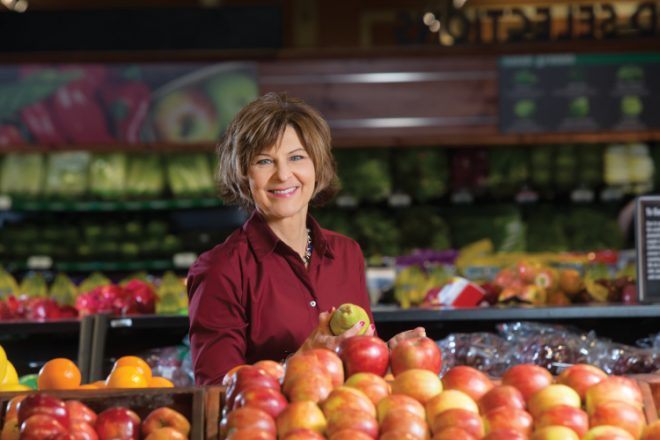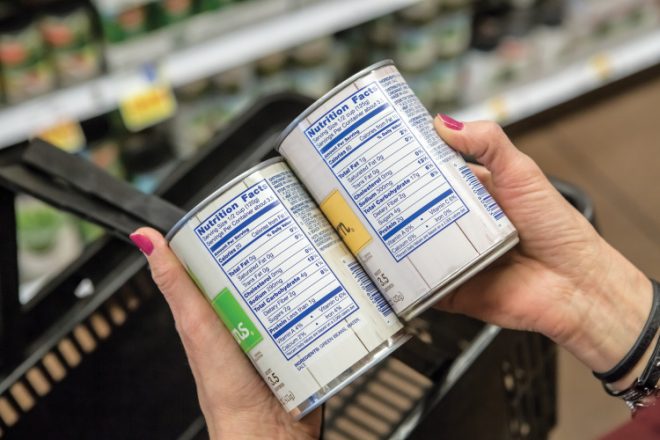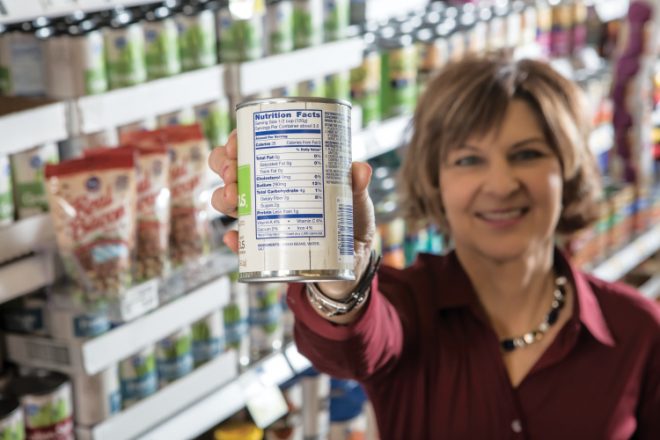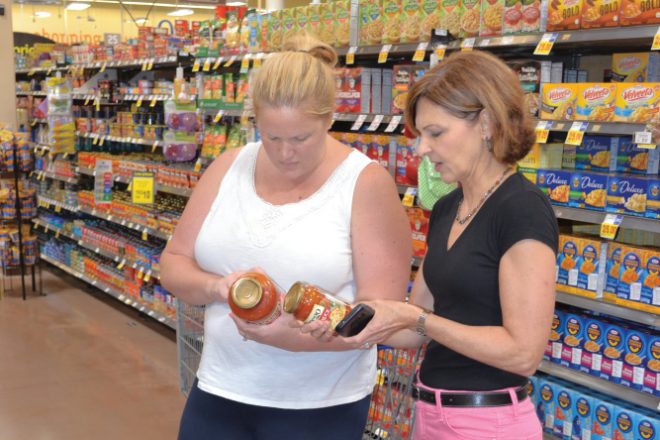Label Lingo

Registered dietician, Kim Galeaz
When a registered dietitian gives a supermarket nutrition tour, you can count on a cart-full of surprises up and down every aisle.
Busting food and nutrition myths. Eliminating fears, guilt and angst with food choices. Clarifying labeling claims and terms.
I accomplished all of this and more when Indiana’s Family of Farmers asked me to take groups of Indiana family and farmer bloggers to various supermarkets recently. We visited three different types of grocery stores to look at affordability, choices and labeling differences. Aldi and Wal-Mart were on one end of the spectrum, specialty stores like Earth Fare, Whole Foods and Fresh Thyme on the other end, and Kroger was the traditional supermarket option in the middle.
At the end of all three visits, the bloggers ended by cooking a recipe with the ingredients from the grocery stores.
During the store visits, I repeatedly told the bloggers that it’s okay to buy, eat and enjoy anything as long those choices are balanced. And balance can mean different things: smaller, sensible portions, choosing an item less frequently, and even getting more activity and exercise to balance those calories. They also heard me reinforce the concept that facts, not fear, should guide what you throw in your grocery cart. Everyone learned that affordable, nutrient-rich food choices are available everywhere, but being a savvy selector and getting past the marketing hype is more important than ever today.
Here are some of the most misunderstood food, nutrition and labeling issues affecting our food choices today, with science-based facts to set the record straight – and prevent unnecessary, budget-busting food choices ending up in your grocery cart.

Contains No Antibiotics
Foods and beverages have never contained antibiotics, even before companies started using this fear-mongering labeling claim. Our government and food system has very strict regulations. Animals must be tested to ensure there are no traces of antibiotics before being processed and ending up in the grocery store. Take milk, for example. If cows have been treated with antibiotics for illness, their milk can’t be used until it’s completely clear of antibiotics. Farmers are extremely conscious of this, as they stand to lose lots of money and product otherwise. Antibiotic use in general is also more regulated and controlled than many consumers realize. These medicines are costly, so farmers use them only when necessary.
No Hormones or No Added Hormones
First of all, hormones are not legal in poultry and pork production. So when you see a label with this claim, it’s simply useless and playing into your fears of hormones. Hormones, by the way, happen to be present in all living things – humans, animals, plants – so many commonly consumed foods contain small amounts of naturally occurring hormones. If hormones are used in dairy and beef cow production for efficiency and to help reduce the carbon footprint, there is no difference in the end product (be it milk or steak) between non-hormone treated and hormone-treated livestock.

Picking Produce
Many people think they need to choose organic fruits and vegetables because conventional offerings are pesticide-laden. This couldn’t be farther from the truth. Pesticides are highly regulated, and there are strict safety standards for any pesticides remaining on our foods.
Conventional and organic are both safe to consume, and if there are any pesticide residues (and by that I mean residues that fall within the allowable levels that pose no risk to human consumption), simply washing with water will remove all or nearly all of those residues. I love the pesticide calculator at safefruitsandveggies.com that helps allay fears about produce pesticides.
Local
Local is not a regulated term. It certainly doesn’t mean more nutrient-rich or healthier for your family. No single state can produce every food item, so if you want choice and variety, supermarkets need to source products from many locations. Keep in mind you’re financially supporting many Indiana state family farmers because their products are actually the brands you see in supermarkets, like Indiana Kitchen pork or Dean’s and Prairie Farms milk. In fact, you can find out where your milk comes from by punching in the carton code at whereismymilkfrom.com.

Fresh Is Best
With fruits and vegetables, canned, frozen, dried and 100-percent juices are just as nutrient-rich as fresh. That’s because they’re picked and packed at their peak so nutrients are retained. You’ll find it easier to eat the recommended servings of fruits and vegetables when you incorporate all varieties. A surprising family-friendly tip? Tomato-based pasta sauce counts as a vegetable!
No High-Fructose Corn Syrup
This is a baseless marketing claim. High-fructose corn syrup (HFCS) is nearly identical in structure to sugar and honey, contains exactly the same amount of calories, and your body can’t tell the difference. HFCS does not “cause” obesity or numerous other suggested health risks. All sugars, regardless of source, need to be enjoyed in moderation.
Ready to shop? Find more helpful fact-based tips, advice and recipes from Kim Galeaz on her website at kimgaleaz.com.
Refacing the Facts
In May 2016, the FDA announced an updated and redesigned Nutrition Facts label for packaged foods. Some of the new label features include:
- Type size for “Calories,” “Servings per container,” and “Serving size” has been increased, and the number of calories for the serving size has been bolded to allow consumers to locate this easily.
- Manufacturers must declare the actual amount, as well as percent daily value of vitamin D, calcium, iron and potassium. Other vitamin and mineral amounts can be added voluntarily.
- “Added sugars” will be included on the label in grams and as percent daily value.
To see all the label changes and additions, visit fda.gov.













 My Indiana Home is produced for Indiana Farm Bureau members. Our mission is to connect you with the food you eat, the Indiana farmers who grow it and a rural lifestyle that is uniquely Hoosier.
My Indiana Home is produced for Indiana Farm Bureau members. Our mission is to connect you with the food you eat, the Indiana farmers who grow it and a rural lifestyle that is uniquely Hoosier.
Leave a Comment